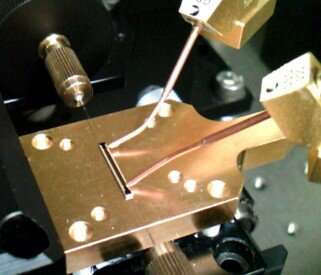Researchers develop ultra-fast polymer modulators that can take the heat

Datacenters could benefit from lower cooling costs due in part to ultra-fast electro-optic modulators developed by researchers in Japan using a polymer that is stable even at temperatures that would boil water.
Reported in the journal Nature Communications, the silicon-polymer hybrid modulators can transmit 200 gigabits of data per second at up to 110 °C and could enable optical data interconnections that are both extremely fast and reliable at high temperatures, reducing the need for cooling and expanding applications in harsh environments like rooftops and cars.
Demand for high-speed data transmission such as for high-definition media streaming has exploded in recent years, and optical communications are central to many of the necessary data connections. A critical component is the modulator, which puts data on a beam of light passing through an electro-optic material that can change its optical properties in response to an electric field.
Most modulators currently use inorganic semiconductors or crystals as the electro-optic material, but organic-based polymers have the advantages that they can be fabricated with excellent electro-optic properties at a low cost and operated at low voltages.
"Polymers have great potential for use in modulators, but reliability issues still need to be overcome for many industry applications," explains Shiyoshi Yokoyama, professor of Kyushu University's Institute for Materials Chemistry and Engineering and leader of the research collaboration.
One challenge is that parts of the molecules in the polymer layer must be organized through a process called poling to obtain good electro-optic properties, but this organization can be lost when the layer gets warm enough to begin softening—a point referred to as the glass transition temperature.
However, if the modulators and other components can operate rapidly and reliably even at high temperatures, datacenters could run warmer, thereby reducing their energy usage—nearly 40% of which is currently estimated to go toward cooling.

Employing a polymer they designed to exhibit superb electro-optic properties and a high glass transition temperature of 172 °C through the incorporation of appropriate chemical groups, the research team achieved ultra-fast signaling at elevated temperatures in a silicon-polymer hybrid modulator based on a Mach-Zehnder interferometer configuration, which is less sensitive to temperature changes than some other architectures.
In the modulators, composed of multiple layers including the polymer and silicon, an incoming laser beam is split into two arms of equal length. Applying an electric field across the electro-optic polymer in one of the arms changes the optical properties such that the light wave slightly shifts. When the two arms come back together, interference between the modified and unmodified beams changes the strength of the mixed output beam depending on the amount of phase shift, thereby encoding data in the light.
Using a simple data signaling scheme of just on and off states, rates of over 100 Gbit/s were achieved, while a more complicated method using four signal levels could achieve a rate of 200 Gbit/s.
This performance was maintained with negligible changes even when operating the devices over temperatures ranging from 25 °C to 110 °C and after subjecting the devices to 90 °C heat for 100 hours, demonstrating the robustness and stability of the modulators over an extraordinarily wide range of temperatures.
"Stable operation even when the temperature fluctuates up to 110 °C is wonderful," says Yokoyama. "This temperature range means operation in controlled environments such as datacenters, even at higher than normal temperatures, and many harsh environments where temperature is not well controlled is possible."
The current devices are millimeter sized, making them relatively large compared to other designs, but the researchers are looking into ways to further reduce the footprint for incorporation of a dense arrays of such modulators in a small area.
"This kind of performance shows just how promising polymers are for future telecommunications technologies," Yokoyama states.
More information: Guo-Wei Lu et al, High-temperature-resistant silicon-polymer hybrid modulator operating at up to 200 Gbit s−1 for energy-efficient datacentres and harsh-environment applications, Nature Communications (2020). DOI: 10.1038/s41467-020-18005-7
Journal information: Nature Communications
Provided by Kyushu University




















